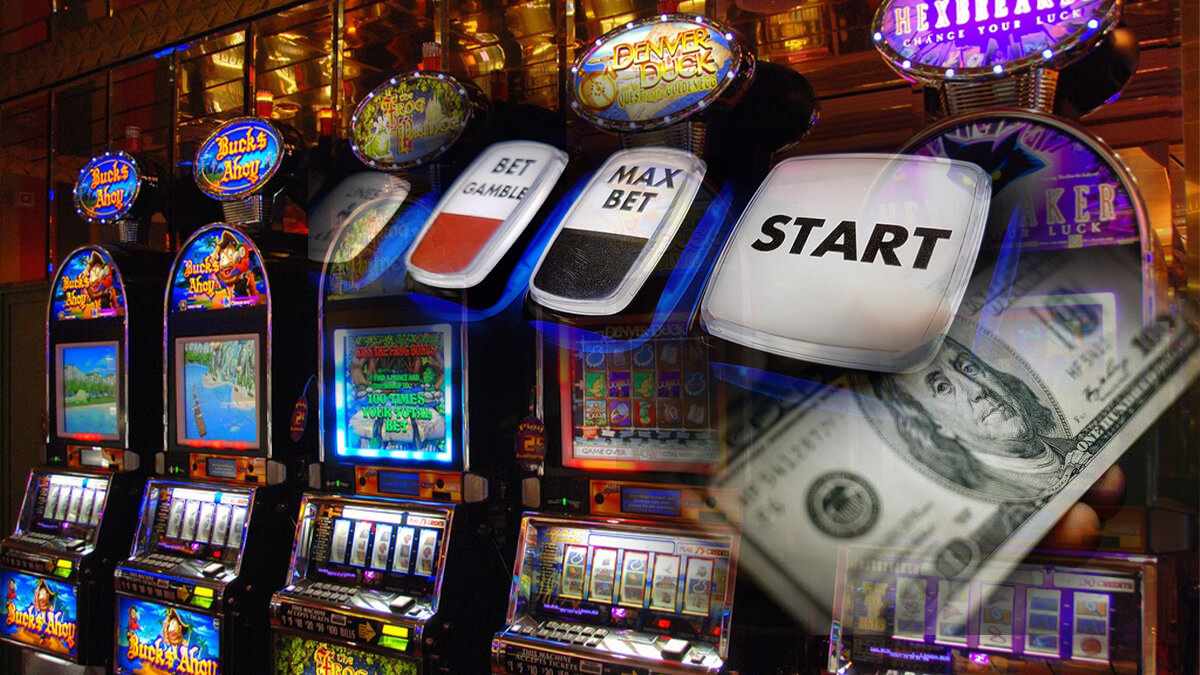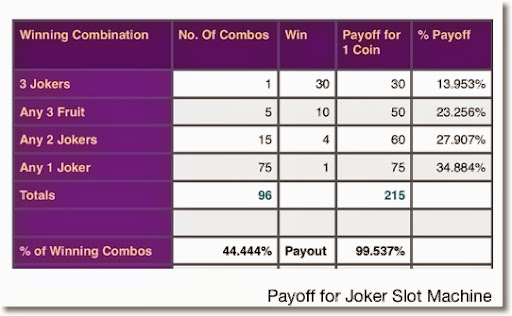Improve Your Odds of Winning at Wheel of Fortune Slots By Stan Rogers on July 17, 2018 There is no doubt that Wheel of Fortune slot machines are some of the most sought-after slot machines in both land and online casinos. Odds of winning on a 100 slot machine. Summing it up It is not enough to know poker rules, and how to play Texas Holdem. Bingo Specials Learn More Bingo Electronic Express Menu Electronic players receive two additional free bonus packs! The slot machine above would return 97.5% to players in the long run. However, we rarely know the odds of slot machines. We do know the paytable - how much each winning combination pays to players - but we have no idea of the probability of getting that winning combination.
Who doesn’t want to improve their chances of winning in the casino?
I know I do.
No one can teach you a method of making sure you’ll walk away from the casino a winner every time. That’s an unrealistic expectation that not even advantage gamblers have.
But you can reduce the amount you’ll lose and increase your chances of winning by making a few either/or choices. I’ve listed 7 of them below.
1 – Play European Roulette Instead of American Roulette
You measure a casino’s advantage over the player with a figure called “the house edge”. That’s a mathematically expected loss per bet expressed as a percentage.
If someone tells you that a game has a 5% house edge, that means you’re expected to lose an average of $5 every time you place a $100 bet. Of course, this is an average over thousands of hands, but as a mathematical concept, it’s a useful way of comparing casino games.
In American roulette, you face 38 different numbers on the roulette wheel. 18 of those numbers are black, 18 are red, and 2 of them are green—the 00 and the 0.
Those two green numbers are where the house gets its edge. A bet on red or black pays off at even odds, but the odds of winning aren’t even. You have 20 ways to lose and 18 ways to win.
Over time, that difference adds up to a 5.26% house edge.
A European style roulette wheel, though, only has 37 numbers. 18 are red, 18 are black, and 1 is green. The bets still have the same payouts, though.
This reduces the house edge for the game from 5.26% to 2.70%.
What does that do to your expected hourly loss?
Let’s say you’re betting $20 per spin, and you’re placing an average of 40 bets per hour. This means you’re putting an average of $800 into action per hour.
Your expected loss on an American roulette wheel is $42.08.
But on a European roulette wheel, your expected loss is only $21.60.
2 – Play Video Poker Instead of Slot Machines
When you’re talking about gambling machines, you talk less about house edge and more about payback percentage. The payback percentage is just the house edge subtracted from 100%. It’s the amount of money you mathematically expect to win back in the long run from a game.
For example, if we say that a slot machine has a payback percentage of 90%, that means you can expect to win back 90% of whatever you gamble in that machine over a long enough time.
But here’s the thing about slot machines:
They don’t list their payback percentages, and there’s no realistic way to guess. We do know that most slot machine games on the Las Vegas Strip pay back at around 92% or so.
But video poker machines, if you play them correctly and choose the games with the best pay tables, pay back much more than that. Even the worst games pay back at 95% or more.
And the best games pay back at 99% or higher.
Best of all, you can determine the payback percentage of a video poker machine based on its pay table. Any respectable video poker site (including our video poker section here), includes common pay tables with their expected payback percentage.
What’s the difference to your bankroll?
Assume you’re playing a slot machine with a 93% payback percentage. You’re making 600 spins per hour at $5 per spin. You’re putting $3000 per hour into action. The casino expects you to lose $210 per hour on that action.
If you’re playing a video poker game with a payback percentage of 99.54% for the same stakes, you’re looking at $3000 in action per hour still.
But your expected loss now is only $13.80.
3 – Master Blackjack Basic Strategy
Blackjack is one of the most popular games in the casino, but if you don’t master basic strategy, you’re probably facing a house edge of 4% or more. Master basic strategy, though, and you can reduce that to between 0.5% and 1% depending on the rules and the table conditions.
What’s basic strategy?
That’s just a fancy way of saying that every possible situation in blackjack has one mathematically best play. For example, you always split aces or 8s. That’s the mathematically best play, and if you make a different decision, the house edge goes up.
What’s the difference between a basic strategy player and someone who’s just winging it?
Let’s assume you’re playing 60 hands per hour for $20 per hand. That’s $1200 per hour in action.
If you’re making a lot of mistakes and ignoring basic strategy, your expected loss per hour is $48.
But if you’re using basic strategy and face a house edge of only 1%, your expected loss per hour is only $12.
Here’s a bonus blackjack tip, too:
Skip the tables where you only get a 6/5 payoff on a natural. That adds almost 2% to the house edge. Insist on playing 3/2 blackjack, or play something else entirely.
4 – Stick with the Simplest Bets at the Craps Table
The number of bets available at the craps table is staggering. The good news is that the bets with the best odds are the easiest bets—the ones at the edges of the table. The inside bets at the craps table come with a much higher edge.
The most basic craps bets are the pass and don’t pass bets. The pass bet is a bet that the shooter will win, and they don’t pass bet is a bet that the shooter will lose.
The shooter loses on the come out roll if she rolls a 2, 3, or 12. She wins on the come out roll if she rolls a 7 or an 11.
If she rolls any other number, a point is set, and she continues to roll the dice until she rolls the point again (winning) or rolls 7 (losing) whichever comes first.
The house edge for the pass bet is 1.41%.
The house edge for the don’t pass bet is 1.36%.
I should point out that even though they don’t pass bet is marginally better, you’ll probably have more fun betting on the pass line. Part of the fun of craps is rooting for the shooter.
Casino Slot Machine Odds Of Winning
I’ll use just one of the proposition bets in the middle of the table as an example of a bet to avoid. The “Any 7” bet pays off at 4 to 1, but the house edge is 16.9%.
Let’s say you’re playing for $10 per roll, and you’re playing at a table where you’re seeing 100 rolls per hour. That means you’re putting $1000 into action every hour.
If you’re betting the pass line, your expected hourly loss is $14.10.
If you’re betting “any seven”, your expected hourly loss is $169.00.

That’s a massive difference.
5 – Always Join the Slots Club
A lot of superstitious players think that if you play with the slots card inserted, your chances of winning go down.

That’s a myth.
This tip almost doesn’t belong here, though, because it makes it sound like you’re more likely to win with the slots club card inserted, but that’s not exactly the case.
What really happens is that the casino measures how much money you’re putting into action per hour so that they can rebate some of it—maybe 0.2%.
What effect does this have on your expected hourly loss?
Let’s look at a hypothetical Jacks or Better video poker player. The house edge is only 0.46%, so if you’re playing 600 hands per hour at $5 per hand, you can expect to lose 0.46% of $3000, or $13.80.
But if you’re getting rewards of 0.2% of your play, you’re getting back $6/hour. That reduces your effective hourly loss to $7.80 per hour.
If you play at a casino which offers double rewards during certain hours, you can eliminate the house edge of even play with a slight margin over the casino.
That’s worth doing.
6 – Take Plenty of Breaks and Play Slowly
This won’t necessarily improve your chances of winning, but it will reduce your expected hourly loss.
You should think of the house edge as a tax on the money that you’re gambling. Every time you place a bet, you pay this tax. That’s not what really happens in the short run, but if you play long enough, that’s exactly what happens.
Let’s look at two slot machine players as examples.
Odds Of Winning On $100 Slot Machine Big Wins
One of them is playing 600 hands per hour at $5 per hand. She’s putting $3000 into action per hour. If the house has an edge of 7%, that player’s expected hourly loss is $210.
The other is only playing 400 hands per hour at $5 per hand. She’s taking her time and taking lots of breaks, so she’s only putting $2000 into action per hour. With the same house edge, she’s only expected to lose $140 per hour.
The slower player might even be having more fun, because she’s probably paying more attention to what she’s doing. I call that mindfulness in action on the casino floor.
7 – Learn to Play the More Complicated Games
Here’s one truism about casino games everyone should know:
The easier the game is to play, the higher the house edge.
Games like Casino War, which require no strategy and are so easy a child could understand them, are best to skip.
Games like blackjack, where strategy plays a big role in how the outcome is determined, offer much better odds.
The house edge for Casino War is 2.33%. The house edge for blackjack is between 0.5% and 1%.
This means you can expect to lose 5 times as much money playing Casino War as you would expect to lose playing blackjack.
The opposite is true of slot machines, though. The more complicated a slot machine game is—more reels, more bonus features, etc.—the higher the house edge has to be to pay for those extra features.
Your best bet with a slot machine is to find one with 3 reels and a flat dollar amount for a jackpot.
Conclusion
Casino games are designed with an unassailable mathematical house edge, but that number varies by game and according to strategy. Your goal as a casino player is to get as much entertainment for your gambling dollar as you can.
The way to do this is to choose the games with the lowest house edge. Go back through the list on this page next time you’re at the casino. This will help you choose games where you will lose money more slowly and have a better chance of walking away a winner.
Please enable JavaScript to view the comments powered by Disqus.